Contents
1. Introduction
2. Evaluation of speed improvement in automatic mesh generation
2.1 Speed measurement model
2.2 Evaluation of parallelization performance
2.3 Correlation evaluation of model complexity and rate of speed improvement
2.4 Mesh Generation Speed Measurement Results
3. Summary
4. References
1. Introduction
Magnetic field simulation tends to be run as a large-scale analysis lately, being backed by the remarkable performance improvement of the computer. JMAG features a high-performance parallel solver in response to the need to perform a large-scale analysis in a shorter amount of time during the design and development phase. However, the model used in a large-scale analysis often contains a large number of parts and complicated shapes, and the time taken for the process of generating a mesh from CAD data is also increasing. Therefore, with the drastic speedup of the solver, the case in which mesh generation time becomes a bottleneck in the entire analysis process has started to be seen. In addition, there are an enormous number of cases where re-meshing may be required in order to adjust the element size, etc. during the analysis process, therefore, the increase in the mesh generation time is becoming a more serious issue. Since Ver.16.1, JMAG has been working on speeding up the automatic mesh generation by reviewing process data and parallelization with multithreading in order to reduce the time of the entire analysis process.
In this paper, we report the evaluation results of the speed improvement in automatic mesh generation after Ver.16.1. For evaluation, the mesh generation time for a respective version starting from Ver.16.0 through the latest Ver.18.0 has been measured for particular models from various applications in magnetic field analysis. Selecting mainly the particular case where mesh generation is extremely time-consuming, especially in Ver.16.0, and the evaluation will be performed to see how much improvement is made with version upgrades. JMAG auto mesh generation feature comes with two generation methods: “semi-auto mesh” and “extruded mesh.” Therefore, the velocity was measured for each of the two methods. Specifications of the computer used for measurement are that the CPU is Intel® Xeon® E5-2697 v4 and the main memory capacity is 64GB.
2. Evaluation of speed improvement in automatic mesh generation
2.1 Speed measurement model
To generate a mesh from CAD data, it is necessary to perform a preprocessing such as checking errors in data and contact between parts, imprinting, and correction of the geometry. There are many cases in which these preprocessing procedures require a long period of time for a model used in large-scale analysis. The following two points particularly can be considered the cause.
A) A large number of parts.
B) Includes multiple spline surfaces.
Case A is understandable since the combination that requires the contact check increases in proportional to the square of the number of parts. In CAD, complex curved surfaces which cannot be expressed by analytical surfaces are represented by spline surfaces. Spline surfaces, in comparison with the plane and analytical surfaces, require a complex processing for contact checks, etc., therefore, the preprocessing of model data that contains a large number of spline surfaces takes a long time. In order to evaluate the speed improvement from these two perspectives, the six models in Table 1 were selected and used for obtaining measurement data on the mesh generation speed. Model 1 and Model 2 are models of generator and motor, respectively. Model 1 has a coil end that is modeled in detail and is composed of many parts. Model 2 contains many poles and slots, resulting in an extremely large number of parts. Both models contain a very large number of spline curves, as described in Table 1. Model 3 is a transformer model, and it contains spline surfaces because of the complicated structure of the coil representing a Litz wire. Model 4 is a model of a solenoid injector, and it is composed of multiple wires for modeling a coil, resulting in an extremely large number of parts. However, since spline surfaces are not included and the whole model is represented by analytical surfaces, we consider that the complexity is low compared with the previous model. Model 5 is a model of a wireless power transfer device. As with other models, it is composed of multiple wires for modeling a coil, resulting in an extremely large number of parts, however, spline surfaces are not included. A model of induction hardening of a crankshaft is Model 6. Among all the models mentioned above, Model 6 is expected to have a mesh generation in a short time, since it has the least number of parts and at the same time, there are no parts having small dimensions.
Table 1 Models used in the measurement
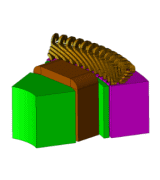 Model 1 |
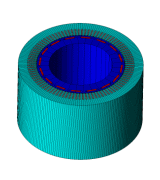 Model 2 |
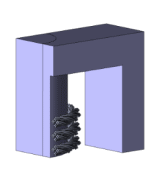 Model 3 |
|
| Model type | 45-degree model | Full model | 1/8 model |
| Number of parts | 288 | 1,024 | 50 |
| Number of surfaces | 10,552 | 7,360 | 208 |
| Number of spline surfaces | 4,756 | 4,800 | 96 |
| Mesh type | Slide (Rotation) | Slide (Rotation) | Standard |
| Automatic healing | None | Yes | Yes |
| Number of elements (Extruded mesh) |
Approx. 2.7 million (Approx. 1.1 million) |
Approx. 7.1 million (Approx. 1.1 million) |
Approx. 3.1 million (Approx. 3.1 million) |
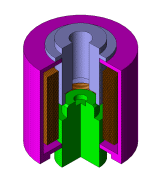 Model 4 |
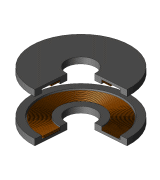 Model 5 |
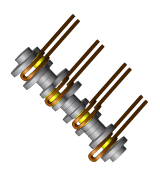 Model 6 |
|
| Model type | Full model | Full model | Full model |
| Number of parts | 503 | 77 | 16 |
| Number of surfaces | 528 | 91 | 188 |
| Number of spline surfaces | 0 | 0 | 0 |
| Mesh type | Standard | Standard | Standard |
| Automatic healing | Yes | Yes | Yes |
| Number of elements (Extruded mesh) |
Approx. 2.2 million (Approx. 1.1 million) |
Approx. 1.1 million (Approx. 0.73 million) |
Approx. 1.5 million (Approx. 0.97 million) |
You need to sign in as a Regular JMAG Software User (paid user) or JMAG WEB MEMBER (free membership).
By registering as a JMAG WEB MEMBER, you can browse technical materials and other member-only contents for free.
If you are not registered, click the “Create an Account” button.
Create an Account Sign in



